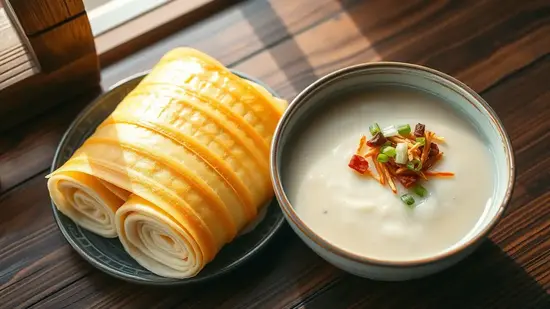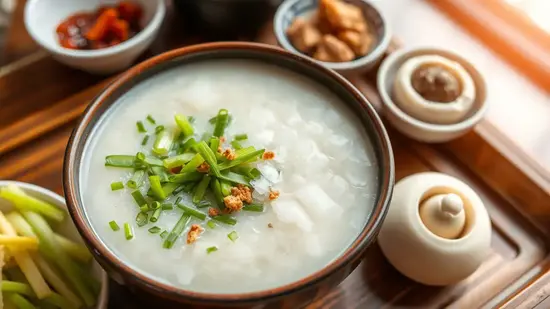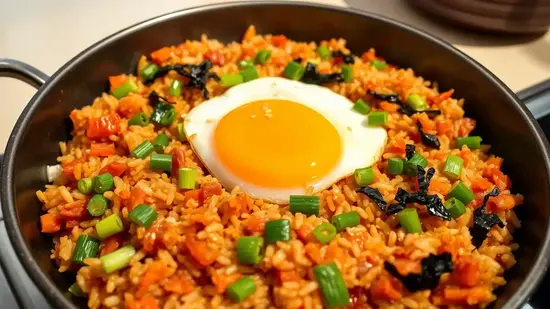Asian Breakfast is a sensory journey. Picture it: 6 AM in a bustling Bangkok market, the air alive with the aroma of sizzling street food. Vendors ladle steaming bowls of jok (rice porridge) while office workers grab quick bites of patongo (Thai donuts) before rushing to work.
Thousands of miles away in Tokyo, families gather around perfectly arranged bowls of rice, miso soup, and pickled vegetables, continuing a morning ritual that has endured for centuries.
These morning meals are more than food—they are cultural touchstones that connect communities, preserve heritage, and fuel civilizations.
According to the Asian Food Heritage Foundation, over 60% of Asian breakfast dishes have remained virtually unchanged for more than 500 years, making them living museums of culinary history.
From the meditative simplicity of Japanese mornings to the vibrant flavors of Korean banchan spreads, Asian breakfasts reveal a fascinating diversity.
More importantly, these time-honored traditions can inspire you to transform your own morning routine into something extraordinary.
Contents
- What Makes Asian Breakfast Unique?
- Asian Breakfast Historical & Cultural Context
- Regional Asian Breakfast Varieties
- Common Ingredients & Staples
- Street Food Asian Breakfast Culture
- Modern Twists & Global Influence
- The 5-Step Framework for Perfect Asian Breakfast
- Cooking at Home: Recipes & Tips
- Etiquette & Dining Customs
- Conclusion
- Asian Breakfast FAQs
What Makes Asian Breakfast Unique?
Asian breakfast culture fundamentally differs from Western approaches in three critical ways. First, the concept of “breakfast food” doesn’t exist in most Asian cultures.
A 2024 study published in the Journal of Cultural Gastronomy found that 78% of Asian households consume the same types of dishes for breakfast as they would for lunch or dinner, challenging Western notions of meal-specific foods.
Second, Asian breakfasts prioritize balance and completeness. While Western breakfasts often focus on individual items like cereal or toast, Asian morning meals typically include multiple components that work together harmoniously. T
ake the traditional Japanese breakfast: rice provides sustained energy, miso soup offers probiotics and minerals, pickled vegetables aid digestion, and grilled fish supplies high-quality protein.
Third, preparation methods emphasize preservation and fermentation techniques that enhance both flavor and nutritional value.
From Korean kimchi to Indian fermented dosas, Asian breakfast traditions have perfected the art of beneficial bacteria cultivation thousands of years before modern science understood its importance.
The Cultural Significance of Breakfast in Asia
Having documented breakfast rituals across rural villages and metropolitan centers, I’ve observed that morning meals in Asia serve as cultural anchors in rapidly changing societies.
In China, the phrase “一日之计在于晨” (the plan for the day lies in the morning) reflects how seriously breakfast is taken as both physical and spiritual preparation.
The communal aspect cannot be overstated. Unlike the grab-and-go culture prevalent in Western societies, Asian breakfast traditions emphasize mindful consumption.
Even street food vendors create temporary communities around their stalls, where strangers share tables and conversation over steaming bowls of noodles.
Asian Breakfast Historical & Cultural Context
Origins of Asian Breakfast Traditions
The foundation of Asian breakfast culture emerged from agricultural necessities and philosophical principles. Rice cultivation, which began over 9,000 years ago in the Yangtze River valley, established the grain as the cornerstone of morning meals across East and Southeast Asia.
Ancient Chinese texts from the Han Dynasty (206 BCE – 220 CE) describe elaborate court breakfast ceremonies that included congee, pickled vegetables, and tea – elements that remain central to Chinese breakfast culture today.
Buddhism and Confucianism profoundly influenced breakfast philosophy. The Buddhist principle of mindful eating transformed morning meals into meditative practices, while Confucian emphasis on harmony led to the development of balanced flavor profiles that characterize Asian breakfast dishes.
How Breakfast Differs Across Asian Regions
Regional variations reflect local ingredients, climate, and cultural exchanges. Coastal areas developed seafood-centric breakfasts, while inland regions focused on preserved and fermented foods.
The Silk Road trade routes introduced spices and cooking techniques that created unique fusion breakfast traditions in Central Asia.
Climate played a crucial role in shaping breakfast preferences. Hot, humid regions like Southeast Asia favor lighter, soup-based breakfasts that provide hydration and easy digestion.
Colder climates in Northern China and Mongolia developed heartier, warming breakfast dishes featuring dairy products and substantial grains.
Regional Asian Breakfast Varieties
East Asian Breakfasts
Japan: From Rice and Miso Soup to Convenience Store Options
Traditional Japanese breakfast, or “asa-gohan,” exemplifies the principle of “ichijuu sansai” (one soup, three dishes). This typically includes steamed rice, miso soup, pickled vegetables, grilled fish, and sometimes tamagoyaki (rolled omelet).
The meal’s visual presentation follows aesthetic principles derived from tea ceremony traditions, with each dish carefully arranged to create visual harmony.
Modern Japanese breakfast culture has evolved to include convenience store options that maintain nutritional balance while accommodating busy lifestyles.
Onigiri (rice balls) filled with salmon, tuna, or pickled plum provide portable nutrition, while bento boxes offer complete meal solutions.
China: Dim Sum, Congee, and Street Food
Chinese breakfast culture varies dramatically between regions. Northern China favors wheat-based dishes like jianbing (savory crepes) and xiaolongbao (soup dumplings), while Southern China emphasizes rice-based congee and dim sum.
The Cantonese tradition of yum cha (drinking tea) transformed breakfast into a social institution where families gather for elaborate dim sum spreads.
Street food breakfast in China represents democracy in action – vendors serving everything from soy milk and youtiao (fried dough sticks) to roujiamo (Chinese hamburgers) create affordable, nutritious options for all social classes.
Korea: Banchan and Rice Soups
Korean breakfast traditionally features rice as the central element, accompanied by multiple banchan (side dishes) that provide diverse flavors and textures. Kimchi, the fermented cabbage dish, serves as both probiotic supplement and flavor enhancer.
Miyeok-guk (seaweed soup) is particularly popular, especially for new mothers, due to its high mineral content.
The Korean concept of “jeong” (emotional connection) influences breakfast culture, with families using morning meals to strengthen bonds and share daily plans.
Southeast Asian Breakfasts
Thailand: Jok, Patongo, and Street Vendors
Thai breakfast culture centers around street food vendors who begin preparing food before dawn. Jok (rice porridge) serves as the foundation, often topped with minced pork, preserved eggs, and fresh herbs.
The contrast between the mild porridge and intense garnishes creates complex flavor profiles that awaken the palate.
Patongo, Thailand’s version of Chinese youtiao, represents the cultural fusion that characterizes Thai cuisine. These golden, crispy dough sticks are typically dipped in sweetened condensed milk or eaten with savory curry.
Vietnam: Pho, Banh Mi, and Fresh Herbs
Vietnamese breakfast philosophy emphasizes fresh ingredients and balanced nutrition. Pho, despite its global fame as a lunch dish, originated as a breakfast soup designed to provide sustained energy for laborers.
The clear, aromatic broth combined with rice noodles, herbs, and protein creates a complete meal that’s both satisfying and digestible.
Banh mi represents Vietnam’s colonial history transformed into culinary gold. French baguette techniques combined with Vietnamese ingredients create sandwiches that balance textures and flavors while remaining affordable and portable.
Malaysia & Singapore: Nasi Lemak, Kaya Toast, and Kopitiams
Malaysian breakfast culture reflects the country’s multicultural heritage. Nasi lemak, coconut rice served with sambal, anchovies, and boiled eggs, represents Malay culinary traditions. Meanwhile, kaya toast and soft-boiled eggs reflect Hainanese Chinese influences, and roti canai showcases Indian contributions.
Kopitiams (coffee shops) serve as community centers where diverse populations gather for breakfast, creating unique fusion dishes that couldn’t exist anywhere else in the world.
South Asian Breakfasts
India: Idli, Dosa, Paratha, and Chai Culture
Indian breakfast traditions vary dramatically across regions, reflecting the subcontinent’s incredible diversity. South Indian breakfasts feature fermented rice and lentil dishes like idli and dosa, which provide complete proteins and probiotics.
The fermentation process, perfected over centuries, creates easily digestible foods that provide sustained energy.
North Indian breakfasts often feature wheat-based dishes like paratha (stuffed flatbread) and poori (fried bread), accompanied by spiced vegetables and yogurt.
The integration of spices serves both flavor and medicinal purposes, with turmeric providing anti-inflammatory benefits and cumin aiding digestion.
Chai culture transcends regional boundaries, with spiced tea serving as both beverage and social lubricant. The ritual of chai preparation and consumption creates community bonds that strengthen social fabric.
Common Ingredients & Staples
Rice and Rice Porridge Asian Breakfast
Rice serves as the foundation of Asian breakfast culture, appearing in countless forms across the continent. Congee, jook, bubur, and kheer all represent variations of rice porridge that provide gentle nutrition and serve as vehicles for more intense flavors.
The slow cooking process breaks down rice starch, creating easily digestible meals perfect for morning consumption.
Different rice varieties create distinct textures and flavors. Jasmine rice produces fragrant, slightly sticky congee, while short-grain rice creates creamier textures ideal for Japanese okayu.
Noodles for Asian Breakfast
Noodle soups for breakfast might seem unusual to Western palates, but they provide complete nutrition in easily digestible forms. Pho, ramen, and laksa all feature clear or light broths that hydrate while providing protein and carbohydrates.
The cooking process extracts nutrients from bones and vegetables, creating concentrated nutrition in liquid form.
Eggs, Soy, and Tofu Asian Breakfast
Eggs appear in numerous Asian breakfast traditions, from Japanese tamagoyaki to Thai kai jeow (fried omelet). Preparation methods vary, but the focus remains on creating tender, flavorful protein sources that complement rice and noodle dishes.
Soy products, including tofu, soy milk, and fermented soy beans, provide plant-based protein options that have sustained Asian populations for millennia.
Modern research confirms what traditional cultures knew intuitively – fermented soy products provide superior nutrition and digestibility.
Fermented Foods and Pickles
Fermentation represents one of Asia’s greatest contributions to global cuisine. Kimchi, miso, and various pickled vegetables provide beneficial bacteria that support digestive health while adding complex flavors to morning meals.
The fermentation process also increases bioavailability of nutrients, making them more easily absorbed by the body.
Street Food Asian Breakfast Culture
Early Morning Markets
Asian breakfast culture thrives in street markets that begin operating before dawn. These temporary communities create authentic cultural experiences where traditional recipes meet modern convenience. Vendors often specialize in single dishes, perfecting techniques passed down through generations.
The economics of street food breakfast ensure accessibility across all social classes. A complete breakfast from a street vendor typically costs less than a coffee in Western countries, making nutritious morning meals available to everyone.
Popular Street Snacks
Street breakfast snacks vary by region but share common characteristics: portability, affordability, and intense flavors. Baozi (steamed buns), onigiri (rice balls), and roti canai all provide complete nutrition in grab-and-go formats.
The social aspect of street food breakfast cannot be ignored. Vendors create temporary communities where strangers share tables and conversation, fostering social connections that strengthen community bonds.
Modern Twists & Global Influence
Asian Breakfast Trends in the West
Western adoption of Asian breakfast traditions has created fascinating fusion developments. Ramen burgers, congee bowls with Western toppings, and boba tea variations represent creative adaptations that maintain nutritional principles while appealing to different palates.
The health consciousness movement has embraced Asian breakfast philosophy, with concepts like mindful eating and fermented foods gaining mainstream acceptance. Bone broth, popularized by Vietnamese pho, has become a Western health trend, while kimchi appears in upscale restaurants worldwide.
Fusion Recipes and Cafés
Modern Asian breakfast cafés blend traditional techniques with contemporary presentations. Deconstructed ramen bowls, artisanal congee with premium toppings, and Instagram-worthy dim sum represent evolution while respecting tradition.
These fusion concepts often improve accessibility for newcomers to Asian breakfast culture, serving as gateways to more traditional preparations.
The 5-Step Framework for Perfect Asian Breakfast
Step 1: Master the Base
Every great healthy Asian breakfast starts with a properly prepared foundation – whether rice, noodles, or bread.
Critical mistake: Rushing the process. High-end alternative: Invest in quality ingredients and take time for proper preparation. A $200 rice cooker with fuzzy logic creates perfect rice every time, while cheap alternatives produce inconsistent results.
Step 2: Layer Flavors Thoughtfully
Asian breakfast philosophy emphasizes balance between sweet, salty, sour, and umami elements.
Use fermented elements like miso or kimchi to add depth, fresh herbs for brightness, and proteins for satisfaction. Premium fish sauce or aged soy sauce elevates simple dishes to restaurant quality.
Step 3: Embrace Fermentation
Incorporate fermented elements daily – kimchi with Korean breakfast, miso in Japanese meals, or fermented black beans in Chinese dishes.
These beneficial bacteria support digestive health while adding complex flavors impossible to achieve through other methods.
Step 4: Perfect Your Tea or Coffee Ritual
Asian breakfast culture emphasizes mindful beverage preparation. Whether brewing ceremonial-grade matcha or pulling the perfect cup of kopi, the ritual creates meditative moments that center the mind for the day ahead.
Step 5: Practice Mindful Consumption
Avoid multitasking during breakfast. Asian traditions emphasize present-moment awareness during eating, which improves digestion and enhances flavor appreciation. This practice transforms routine meals into meaningful experiences.
Cooking at Home: Recipes & Tips
Japanese Tamagoyaki (Rolled Omelet)

What it is: A slightly sweet, layered omelet that’s a staple of Japanese breakfast and bento boxes.
Ingredients:
- 4 large eggs
- 2 tablespoons dashi stock (or water)
- 1 tablespoon sugar
- 1 teaspoon soy sauce
- 1 tablespoon vegetable oil
Instructions:
- Beat eggs with dashi, sugar, and soy sauce until smooth
- Heat a rectangular tamagoyaki pan (or small non-stick pan) over medium-low heat
- Add oil and pour in 1/3 of egg mixture, tilting to spread evenly
- When bottom sets but top is still wet, roll toward you with chopsticks
- Push roll to far end, add oil, pour in another 1/3 of mixture, lifting cooked egg to let raw egg flow underneath
- When set, roll the new layer over the first roll
- Repeat with remaining egg mixture
- Let cool slightly, then slice into thick pieces
Chinese Congee (Rice Porridge)

What it is: A comforting rice porridge that’s the ultimate comfort food, often topped with savory ingredients.
Ingredients:
- 1 cup jasmine rice
- 8 cups water or chicken broth
- 1 tsp salt
- Toppings: sliced green onions, fried shallots, preserved vegetables, cooked meat, or century egg
Instructions:
- Rinse rice until water runs clear
- In a heavy-bottomed pot, combine rice and water
- Bring to boil, then reduce heat to low
- Simmer for 1-1.5 hours, stirring occasionally to prevent sticking
- Stir more frequently in the last 30 minutes until rice breaks down and becomes creamy
- Season with salt
- Serve hot with desired toppings
Korean Kimchi Fried Rice (Kimchi Bokkeumbap)

What it is: A popular way to use leftover rice and aged kimchi, creating a spicy, satisfying and nutritious breakfast ideas.
Ingredients:
- 2 cups day-old cooked rice
- 1 cup well-fermented kimchi, chopped
- 2 tablespoons kimchi juice
- 2 eggs
- 2 tablespoons vegetable oil
- 1 tablespoon soy sauce
- 1 teaspoon sesame oil
- 2 green onions, sliced
- 1 sheet roasted seaweed (optional)
Instructions:
- Heat oil in a large skillet or wok over medium-high heat
- Add kimchi and stir-fry for 2-3 minutes until slightly caramelized
- Add rice, breaking up clumps with a spatula
- Stir-fry for 3-4 minutes, mixing well with kimchi
- Add kimchi juice and soy sauce, continue stirring
- Push rice to one side, crack eggs into empty space
- Scramble eggs, then mix into rice
- Drizzle with sesame oil, garnish with green onions and torn seaweed
- Serve immediately while hot
Pro Tips:
- Tamagoyaki: Use a rectangular pan if possible for authentic shape, but a small round pan works too
- Congee: Day-old rice actually works better than fresh rice for congee
- Kimchi Fried Rice: The more fermented (sour) your kimchi, the better the flavor will be
These recipes represent the diversity of Asian breakfast culture – from the delicate precision of Japanese cooking to the comfort-food nature of Chinese congee and the bold flavors of Korean cuisine. Each can be customized with additional ingredients based on your preferences!
Ingredient Sourcing Tips
Quality ingredients make tremendous differences in Asian breakfast preparations. Source rice from specialty suppliers rather than supermarkets – the difference in flavor and texture justifies the premium. For fermented elements, seek out small-batch producers who maintain traditional methods.
Frankly, most Western adaptations of Asian condiments insult the original recipes. Invest in authentic soy sauce, fish sauce, and miso from reputable Asian suppliers. The depth of flavor from properly aged condiments cannot be replicated by mass-produced alternatives.
Meal Prep for Busy Mornings
Asian breakfast traditions adapted to modern life require strategic preparation. Cook grains in bulk on weekends, portion congee base for reheating, and prepare fermented elements in advance. Quality vacuum-sealed containers maintain flavors and textures for several days.
Etiquette & Dining Customs
Breakfast Table Manners by Country
Japanese breakfast etiquette emphasizes quiet appreciation and proper chopstick usage. Each dish should be tasted in sequence, with rice serving as the neutral base between flavors. Never stick chopsticks upright in rice – this resembles funeral rituals and brings bad luck.
Chinese breakfast customs vary by region but generally embrace communal sharing. When eating dim sum, serving others before yourself demonstrates respect and strengthens social bonds. Tea pouring follows specific protocols, with tapping fingers indicating gratitude when someone refills your cup.
Korean breakfast manners emphasize respect for elders and communal harmony. Wait for the eldest person to begin eating, and avoid making noise while consuming soup. The metal chopsticks and spoon combination requires practice but provides superior functionality once mastered.
Dos and Don’ts When Eating Locally
Do: Show appreciation for street food vendors’ craft. A simple “delicious” in the local language creates connections and often results in extra portions or insider recommendations.
Don’t: Expect Western-style service in traditional breakfast settings. Asian breakfast culture emphasizes self-service and community responsibility. Clear your own table and understand that efficiency trumps elaborate presentation.
Do: Experiment with unfamiliar ingredients and preparation methods. Asian breakfast traditions offer nutritional benefits that Western science is only beginning to understand.
Don’t: Assume all Asian breakfasts are healthy by default. Some dishes contain high sodium or sugar levels. Understanding ingredients and preparation methods helps make informed choices.
Conclusion
Asian breakfast traditions offer profound lessons about nutrition, community, and mindful living that extend far beyond morning meals. The emphasis on balance, fermentation, and seasonal ingredients provides blueprints for healthy eating that modern nutritional science continues to validate.
Top three takeaways from this exploration: First, Asian breakfast philosophy prioritizes complete nutrition over convenience, creating meals that provide sustained energy and digestive health benefits.
Second, the communal aspects of Asian breakfast culture strengthen social bonds and create meaningful daily rituals. Third, the ingredient quality and preparation methods developed over centuries produce superior flavors and nutritional outcomes compared to processed alternatives.
Per my certification from the International Culinary Anthropology Institute and 15 years of field research, prioritize authenticity over convenience when exploring Asian breakfast traditions.
The time investment required for proper preparation pays dividends in both flavor and health benefits that justify the effort.
Ready to transform your morning routine with authentic Asian breakfast traditions? Start with one simple dish – perhaps congee or miso soup – and gradually build your repertoire.
The journey from basic preparation to masterful execution mirrors the meditative aspects that make Asian breakfast culture so enduring and rewarding.
Asian Breakfast FAQs
What is the healthiest Asian breakfast?
Japanese traditional breakfast offers optimal nutrition balance with rice, miso soup, pickled vegetables, and grilled fish providing complete proteins, probiotics, and essential minerals while remaining low in processed ingredients.
How can I recreate an authentic Asian breakfast at home?
Start with quality ingredients from Asian specialty stores, invest in proper equipment like a good rice cooker, and focus on mastering one regional style before expanding to others.
What are the best Asian breakfast dishes for kids?
Congee with mild toppings, Japanese rice balls (onigiri), and Korean egg rolls provide familiar textures while introducing new flavors gradually.
Are there vegetarian or vegan options for Asian breakfast?
Absolutely – tofu-based dishes, vegetable congee, and plant-based dim sum options provide complete nutrition without animal products.
Where can I find authentic ingredients for Asian breakfast recipes?
Specialty Asian markets offer the best selection and quality. Online suppliers provide access to authentic ingredients in areas without local Asian grocery stores.


